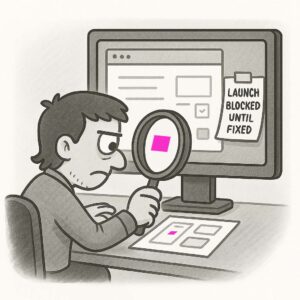Lipstick on a pig describes the act of superficially improving the visual appearance of a product or feature, without addressing its deeper flaws or usability problems. This happens when designers apply a new coat of paint to a bad experience, hoping that users won’t notice the core issues lurking underneath.
ORIGIN
The phrase comes from an old American saying: “You can put lipstick on a pig, but it’s still a pig.” In other words, no matter how much you dress something up, it’s still fundamentally the same thing.
In UX, it warns against prioritizing visual polish over fixing real user needs, broken workflows, or structural problems.
WHEN
You’ll see lipstick on a pig when:
- A broken or confusing flow gets new colors, icons, and rounded corners, but remains just as frustrating.
- A legacy product gets a rebrand without addressing technical debt or outdated patterns.
- Stakeholders demand “a fresh new look” while ignoring negative usability testing results.
- A marketing-driven redesign focuses only on surface impressions.
It’s particularly common in organizations that value appearances over substance, or when time and budget only allow for a facelift instead of a real fix.
WHY
Lipstick on a pig happens because:
- It’s faster and cheaper to update visuals than rethink workflows.
- Teams may not have the resources, mandate, or data to tackle deeper problems.
- Surface-level changes feel like progress, even if they don’t solve anything meaningful.
But users aren’t fooled for long. The novelty wears off, and the underlying pain points remain.
HOW
Here’s how to avoid putting lipstick on a pig:
- Start with research. Understand what’s really broken before making cosmetic changes.
- Fix workflows first. Improve the structure, logic, and usability before styling.
- Validate changes. Test with real users to ensure the redesign improves outcomes.
- Communicate honestly. Don’t oversell superficial changes as a total solution.
- Plan deeper work. If you must start with visual refreshes, set a clear roadmap to tackle root problems next.
PRO TIP
When planning a redesign, ask: “If we stripped away the new visuals, would the experience still feel better?” If not, it’s just lipstick.
EXAMPLES
- A website that updates to a modern color palette but still buries key actions under poor navigation.
- A SaaS dashboard with flashy new charts but the same unhelpful, overwhelming data.
- A checkout flow redesigned to “look sleek” but still forces users through five confusing steps.
CONCLUSION
Lipstick on a pig reminds us that real UX improvements start beneath the surface. Pretty pixels won’t hide a broken experience for long.
Also known as: Mullet UI (closely related) • Polishing a turd (more blunt) • Window dressing



